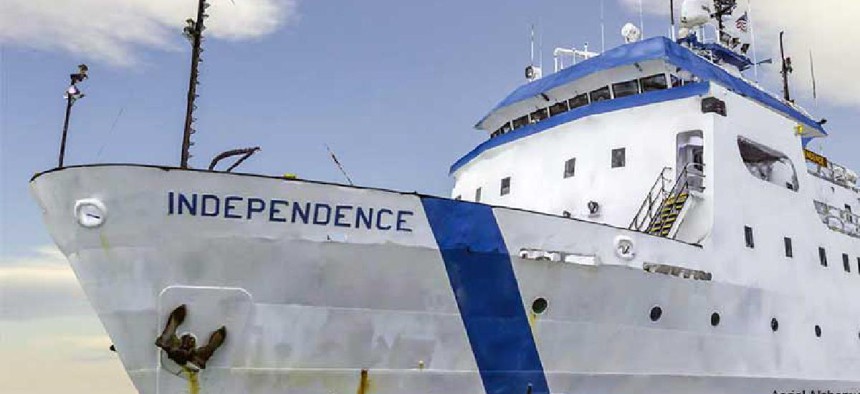How digital twins keep Navy ahead on ship maintenance
With a digital twin of a ship, the Navy can conduct shipboard repairs and maintenance while at sea, ensuring the readiness of combat systems without the need to dock.
With a digital twin of a ship, the Navy can conduct shipboard repairs and maintenance while at sea, ensuring the readiness of combat systems without the need to dock.
The Naval Surface Warfare Center (NSWC) in Port Hueneme, Calif., has been working with Aerial Alchemy, an unmanned aerial systems company, to research ways to use digital twins and UAS for this purpose. A Cooperative Research and Development Agreement signed in June 2018 laid out the specifics, and the company produced a digital twin of the research vessel “Independence.”
The initial plan was to create a digital twin of the ship so maintenance engineers at the surface warfare centers could identify damage, corrosion and alignment issues faster and be more proactive on the maintenance when the ship comes into port, Aerial Alchemy Founder and CEO Chuck Spaulding said.
Traditionally, ship inspections have been conducted manually, which often means the vessels must be in port. With a digital twin, however, sensor data collected by drones can be distributed to colleagues on shore – or vice versa – for inspection. Alternatively, the Navy can make sure that when the ship comes to port, the right people and tools are on hand to fix what’s broken.
“Because it’s the Navy, things happen at sea where maybe something gets damaged, maybe something fails,” Spaulding said. “This way, they can start getting this information back to the maintenance commands quicker and then have a tool -- a digital twin -- that they can now evaluate.”
Scans from drones and onboard photogrammetry were used to create time-based, geotagged, metadata-dense models of the Independence, which are far more actionable datasets for maintenance engineers, according to the Federal Laboratory Consortium for Technology Transfer. Having this digital twin results in lower maintenance costs and human error because experts onboard and on shore can view the same reliable data and make decisions before degradation hits the point of failure.
“Our ability as in-service engineers to support the fleet currently requires extensive on-site personnel in order to identify configuration, damage, corrosion and other mechanical issues,” Alan Jaeger, manager of Naval Sea Systems Command’s Office of Research and Technology Applications, said in a statement. “The concept of a ‘digital twin’ or as-built models of surface ships provides extensive opportunities to better serve the fleet. Imagine being able to not only collect valuable information without placing maintenance personnel in potentially hazardous situations, but to also do it with the ship underway while obtaining better and more accurate data in the process."
When creating a digital twin, the company starts with a discovery phase to determine the appropriate remote-sensing technologies and design a purpose-built UAS that can collect the most useful data in the most practical way. The company uses LiDAR and hyperspectral imaging, which analyzes information from across the electromagnetic spectrum, and can detect corrosion because paint reflects radiation differently if there is underlying rust, Spaulding said.
The digital twin also creates a single source of truth about the ship. “When you remodel a house, you’ll notice you have one prime contractor and you’ll have four or five subcontractors,” he said. “If you pay attention to the blueprints they’re looking at, they’re not all the same blueprints. They’re looking at different variations of the same thing based on when they got it. This is a way to sync all of this up so that everybody knows they’re all communicating about the same issues.”
“3D scanning is fundamentally important for digital engineering to support naval readiness,” said Don Brutzman, an associate professor at the Naval Postgraduate School, in an email to GCN.
“Aerial Alchemy’s combination of custom [unmanned aerial vehicles], high-resolution scanning sensors and compute-intensive postprocessing is innovative and unique,” he said. “Further government-industry cooperation is needed to make such achievements repeatable and reusable over programmatic life cycles.”
The project is part NSWC’s Naval Innovative Science and Engineering research on technologies that can advance the future of in-service engineering. The Federal Technology Transfer Act of 1986 allows warfare centers and research laboratories to collaborate with industry and academic in research, engineering and technology development.
This article first appeared on GCN, a partner site with Defense Systems.





